Study on the Single Sheet Measurement Method for AC Magnetic Measurement on Grain-Oriented Electrical Steel
Abstract
1. Introduction
2. Methodology
2.1. Measuring Principle of the Magnetizing Current Method (MC)
2.2. System Structure and Measuring Principle of H-coil
2.3. Experimental Method
3. Experimental Results and Discussion
3.1. The Measurement Differences between the HC and MC Methods
3.2. Measurement Deviation Caused by the Yokes
3.3. The Correlation between HC and MC Methods
4. Conclusions
- (1)
- The HC method eliminates the measurement systematic error caused by assumed effective magnetic path length, and the measured specific total loss, excitation power, and other magnetic performance indexes are significantly lower than those measured by the MC method. The HC method is a reliable alternative method for the magnetic property measurement on electrical steels in the future.
- (2)
- The actual effective magnetic path length in the MC method can be examined based on the systematic deviation between the measurement results obtained by HC and MC methods under different magnetic polarization intensities with the specific total loss induced by the yoke deducted.
- (3)
- The actual effective magnetic path length in the MC method is not a constant, which depends on the sample characteristics, the measurement conditions, and the material and manufacturing process of the permeameter. The actual effective magnetic path length of the MC method is larger than 450 mm, and fluctuates around 468 mm.
- (4)
- Under the current measurement system of the single sheet method SST (92), the assumed effective magnetic circuit length of 468 mm is recommended; meanwhile, the final measurement result should be corrected according to the actual yoke loss.
Author Contributions
Funding
Data Availability Statement
Conflicts of Interest
References
- Jain, V.; Modak, P.; Patra, S.; Ghosh, A. Origin of Goss texture in grain oriented electrical steel: Role of shear bands. Materialia 2022, 22, 101398. [Google Scholar] [CrossRef]
- Mirabal, L.M.; Messal, O.; Benabou, A.; Le Menach, Y.; Roger, J.Y.; Ducreux, J.P. Experimental study of grain oriented electrical steel laminations under 3D magnetic flux excitation. J. Magn. Magn. Mater. 2022, 564, 170077. [Google Scholar] [CrossRef]
- Sievert, J. The measurement of magnetic properties of electrical sheet steel-survey on methods and situation of standards. J. Magn. Magn. Mater. 2000, 215, 647–651. [Google Scholar] [CrossRef]
- Stupakov, O. System for controllable magnetic measurement with direct field determination. J. Magn. Magn. Mater. 2012, 324, 631–636. [Google Scholar] [CrossRef]
- Yamamoto, T.; Ohya, Y. Single sheet tester for measuring core losses and permeabilities in a single sheet tester. IEEE Trans. Magn. 1974, 10, 157–159. [Google Scholar] [CrossRef]
- IEC 60404-3; Magnetic Materials–Part 3: Methods of Measurement of the Magnetic Properties of Electrical Steel Strip and Sheet by Means of a Single Sheet Tester. International Electrotechnical Commission: Geneva, Switzerland, 1992.
- IEC 60404-3; Magnetic Materials–Part 3: Methods of Measurement of the Magnetic Properties of Electrical Steel Strip and Sheet by Means of a Single Sheet Tester. International Electrotechnical Commission: Geneva, Switzerland, 2010.
- Sievert, J.; Ahlers, H.; Fiorillo, F.; Rocchino, L.; Hall, M.J.; Henderson LC, A. Magnetic measurements on electrical steels using Epstein and SST methods. In Proceedings of the 6th International Workshop on 1&2-Dimensional Measurement and Testing, Bad Gastein, Austria, 20–21 September 2000; pp. 194–203. [Google Scholar]
- Paltanea, V.M.; Paltanea, G.; Gavrila, H.; Dumitru, L. Experimental analysis of magnetic anisotropy in silicon iron steels using the single strip tester. In Proceedings of the 2015 9th International Symposium on Advanced Topics in Electrical Engineering (ATEE), Bucharest, Romania, 7–9 May 2015. [Google Scholar]
- Chen, D.X.; Zhu, Y.H. Effective magnetic path length in Epstein frame test of electrical steels. Rev. Sci. Instrum. 2022, 93, 055105. [Google Scholar] [CrossRef] [PubMed]
- IEC 60404-8-7; Magnetic Materials-Part 8-7: Specifications for Individual Materials- Cold-Rolled Grain-Oriented Electrical Steel Strip and Sheet Delivered In The Fully-Processed State. International Electrotechnical Commission: Geneva, Switzerland, 2020; Volume 9.
- JIS C 2556:2015; Methods of Measurement of the Magnetic Properties of Electrical Steel Strip and Sheet by Means of a Single Sheet Tester. Japanese Standards Association: Tokyo, Japan, 2015.
- Nakata, T.; Kawase, Y.; Nakano, M. Improvement of measuring accuracy of magnetic field strength in single sheet testers by using two H coils. IEEE Trans. Magn. 1987, 23, 2596–2598. [Google Scholar] [CrossRef]
- GB/T39042-2020; National Standard of the People’s Republic of China: Measurement of the Magnetic Properties of Electrical Steels by Means of a Single Sheet Tester-H-coil Method. Standardization Administration of China: Beijing, China, 2020.
- JIS C 2556: 1996; Japanese Industrial Standard: Method of Measurement of the Magnetic Properties of Magnetic Steel Sheet and Strip by Means of a Single Sheet Tester. Japanese Standards Association: Tokyo, Japan, 1996.
- Chen, C.; Song, W.; Zhou, X. Study and Analysis of Yoke Loss of Single Sheet Tester for Magnetic Properties Measurement of Electrical Steel. Metrol. Sci. Technol. 2022, 66, 49–54. [Google Scholar]
- Nakata, T.; Ishihara, Y.; Nakaji, M.; Todaka, T. Comparison between the H-coil method and the magnetizing current method for the single sheet tester. J. Magn. Magn. Mater. 2000, 215, 607–610. [Google Scholar] [CrossRef]
- Mailhe, B.J.; Ricardo, D.; Silva, I.; Sadowski, N.; Batistela, N.J.; Kuo-Peng, P. Influence of Shielding on the Magnetic Field Measurement by Direct H-Coil Method in a Double-Yoked SST. IEEE Trans. Magn. 2017, 54, 1–4. [Google Scholar] [CrossRef]
- Kutsukake, A.; Kido, Y.; Ikeda, T.; Kanada, T.; Enokizono, M. Phase Correction for High Precision Measurement of Iron Loss using H-coil Method. IEEJ Trans. Fundam. Mater. 2012, 132, 441–447. [Google Scholar] [CrossRef]
- Marketos, P.; Zurek, S.; Moses, A.J. Calculation of the mean path length of the Epstein frame under non-sinusoidal excitations using the double Epstein method. J. Magn. Magn. Mater. 2008, 320, 2542–2545. [Google Scholar] [CrossRef]
- Sievert, J.D.; Son, D. On the effective magnetic path length used for field strength and loss determination. J. Magn. Magn. Mater. 1984, 41, 235–237. [Google Scholar] [CrossRef]
- Hofmann, M.; Kahraman, D.; Herzog, H.G.; Hoffmann, M.J. Numerical Determination of the Effective Magnetic Path Length of a Single-Sheet Tester. IEEE Trans. Magn. 2014, 50, 929–932. [Google Scholar] [CrossRef]
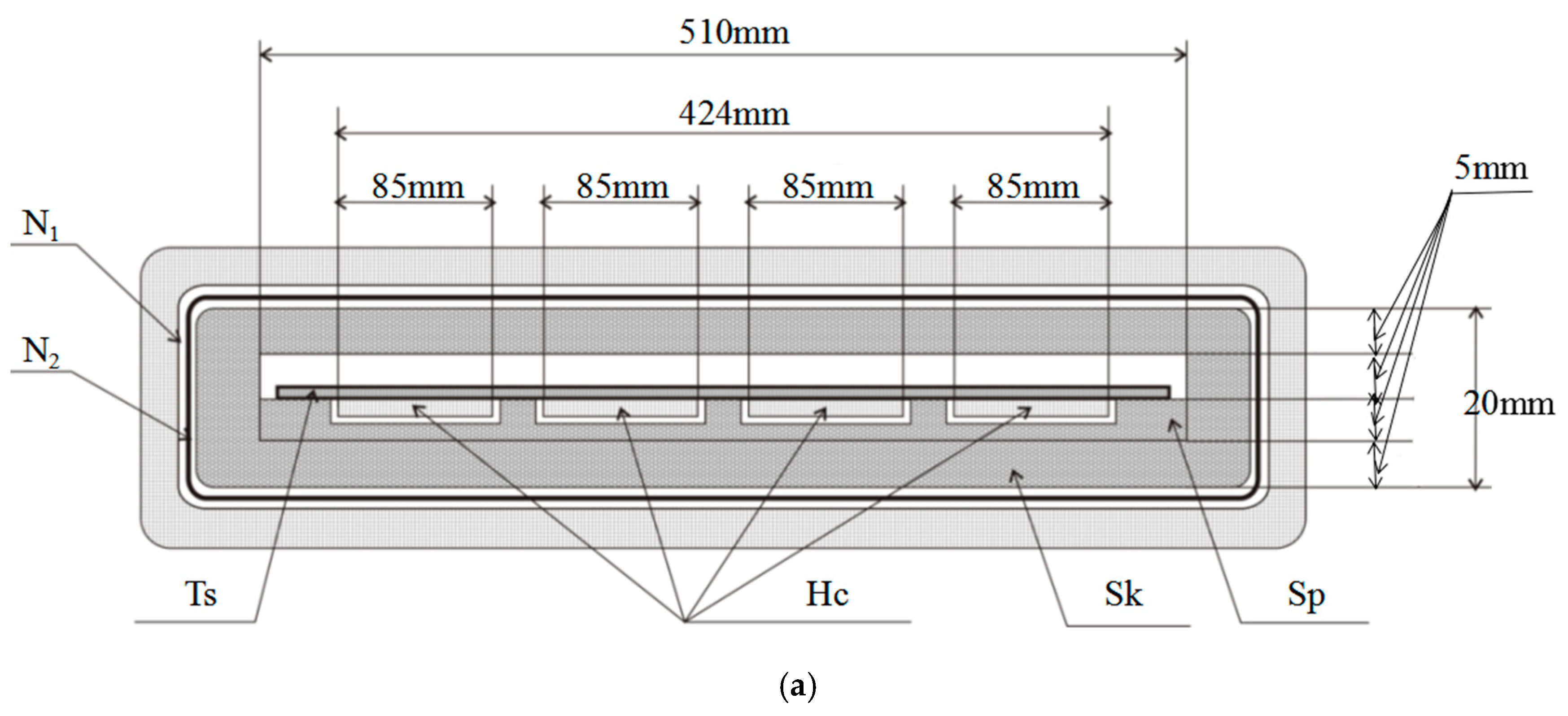

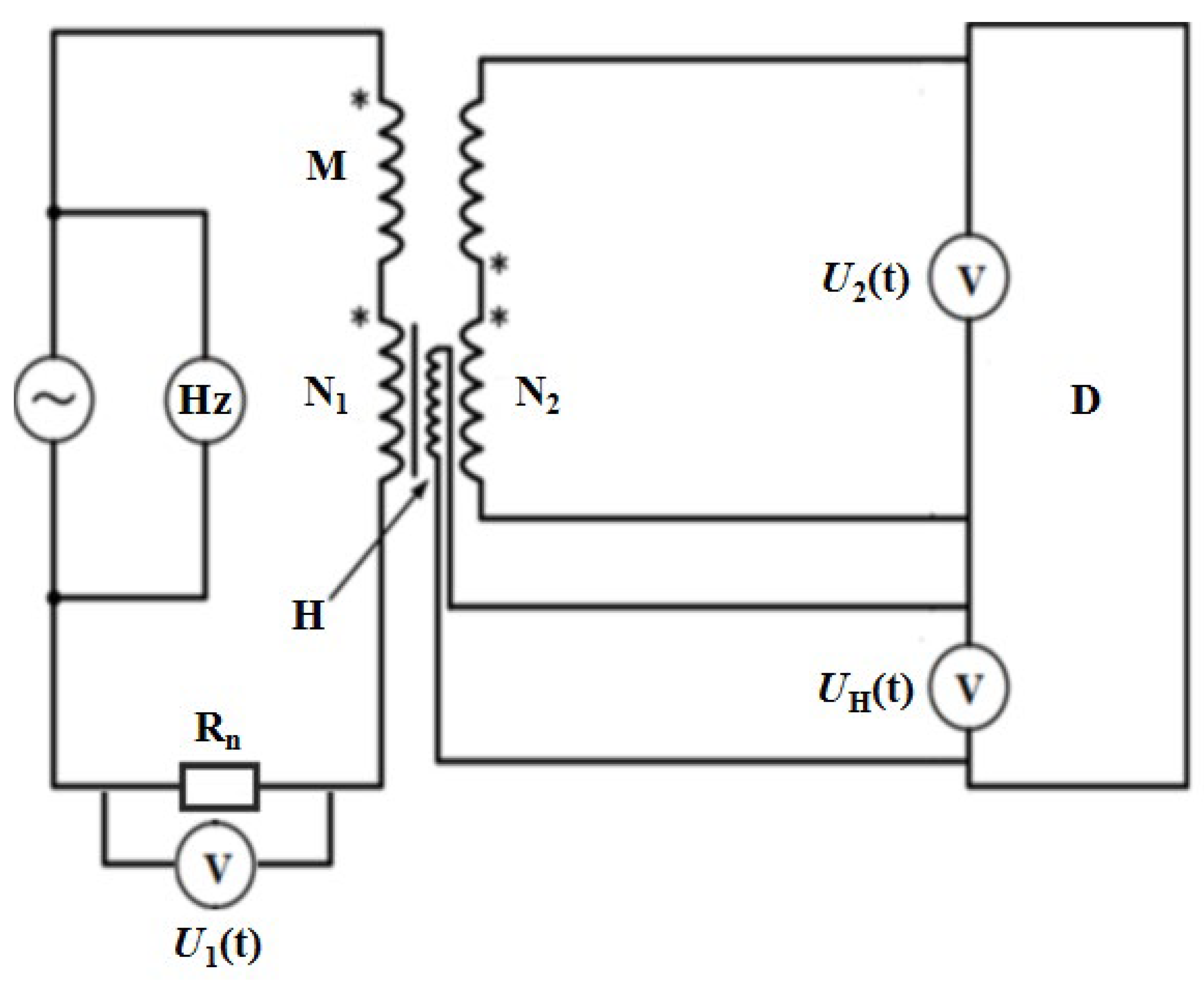

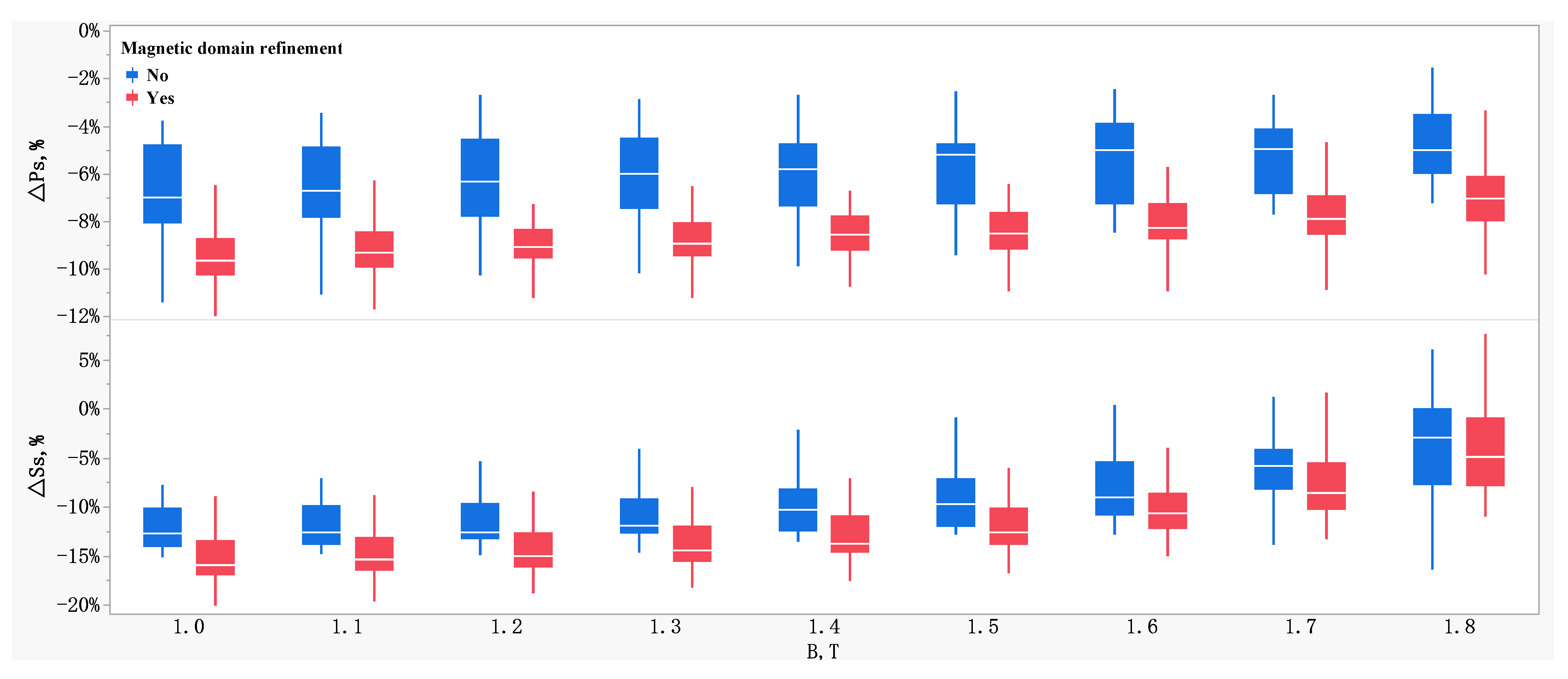
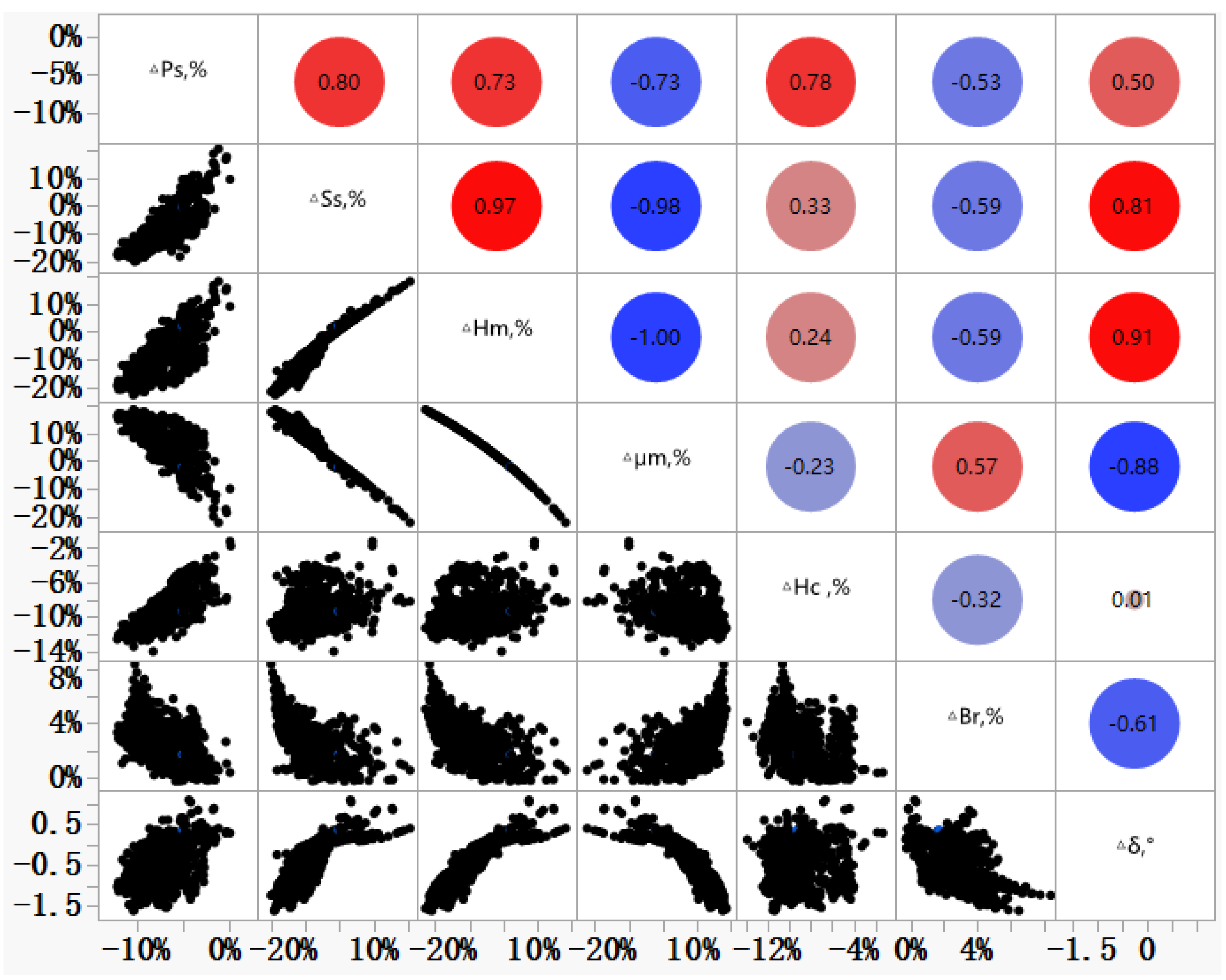
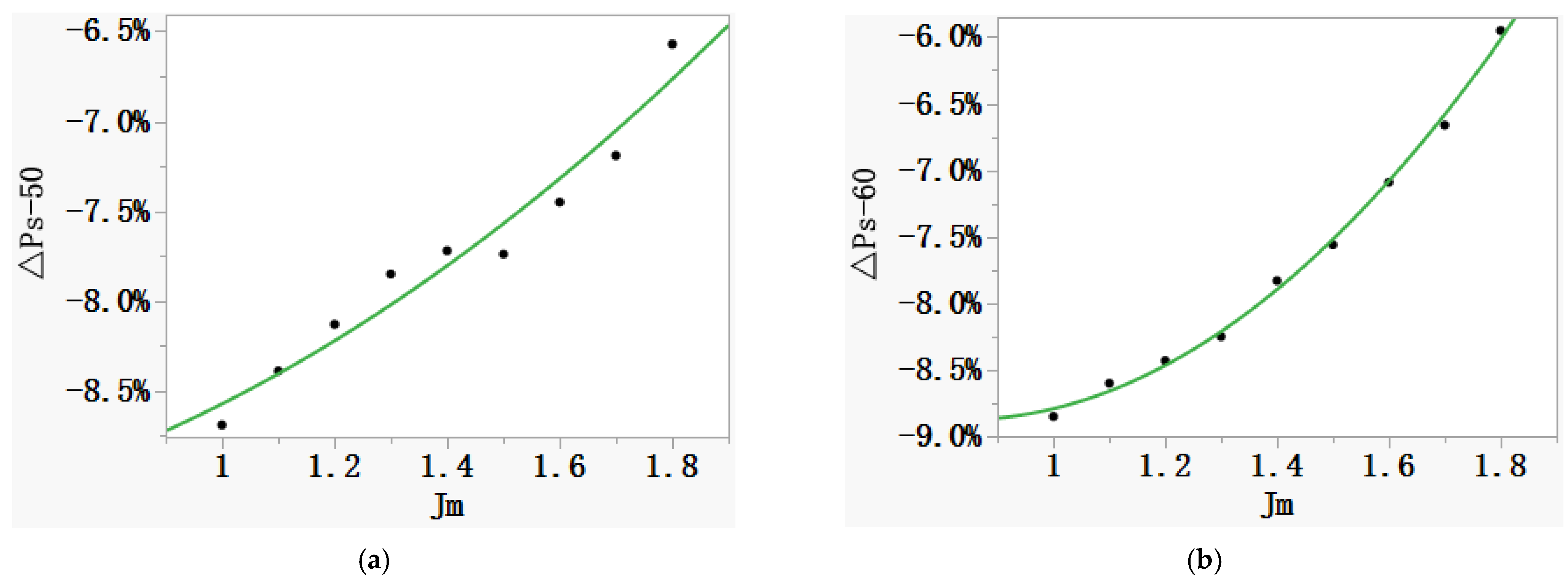
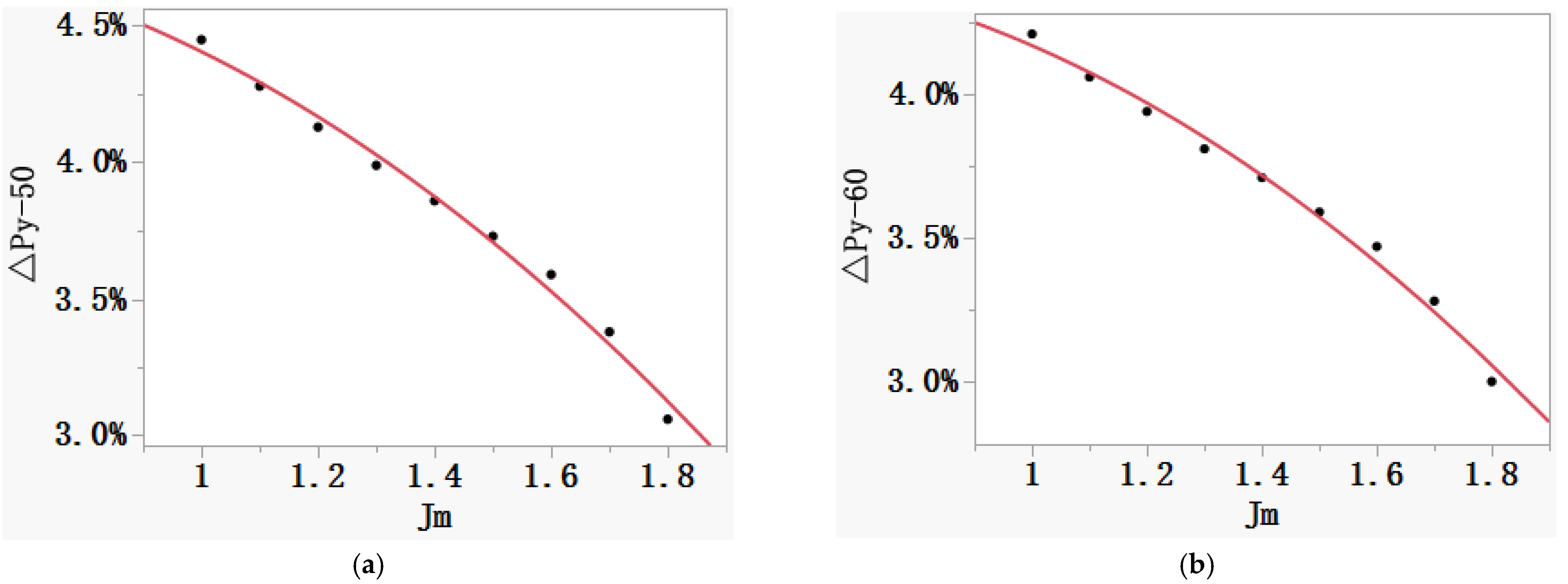
| f, Hz | Jm, T | ΔHm, A/m | ΔHc, A/m | ΔBr, T | Δμm, mH/m | ΔPs, W/kg | ΔSs, VA/kg |
|---|---|---|---|---|---|---|---|
| 50 | 1.0 | −15.93% | −9.20% | 4.36% | 13.63% | −8.69% | −14.61% |
| 1.1 | −16.05% | −9.13% | 4.04% | 13.77% | −8.39% | −14.18% | |
| 1.2 | −15.62% | −9.08% | 3.62% | 13.44% | −8.13% | −13.71% | |
| 1.3 | −14.53% | −9.05% | 3.22% | 12.62% | −7.85% | −13.03% | |
| 1.4 | −13.10% | −9.14% | 2.82% | 11.47% | −7.72% | −12.33% | |
| 1.5 | −11.43% | −9.45% | 2.49% | 10.10% | −7.74% | −11.46% | |
| 1.6 | −8.87% | −9.56% | 2.21% | 7.99% | −7.45% | −9.76% | |
| 1.7 | −5.68% | −9.86% | 2.09% | 5.21% | −7.19% | −7.38% | |
| 1.8 | −2.66% | −9.93% | 2.15% | 2.29% | −6.57% | −4.00% | |
| 60 | 1.0 | −15.16% | −9.31% | 3.76% | 13.05% | −8.85% | −14.03% |
| 1.1 | −15.43% | −9.23% | 3.43% | 13.26% | −8.60% | −13.69% | |
| 1.2 | −15.31% | −9.24% | 3.05% | 13.15% | −8.43% | −13.36% | |
| 1.3 | −14.44% | −9.29% | 2.72% | 12.48% | −8.25% | −12.87% | |
| 1.4 | −12.83% | −9.16% | 2.42% | 11.25% | −7.83% | −11.90% | |
| 1.5 | −11.11% | −9.19% | 2.24% | 9.87% | −7.56% | −10.97% | |
| 1.6 | −8.61% | −9.11% | 2.09% | 7.80% | −7.09% | −9.34% | |
| 1.7 | −5.37% | −9.09% | 2.04% | 4.96% | −6.66% | −6.97% | |
| 1.8 | −2.03% | −8.95% | 2.09% | 1.72% | −5.95% | −3.36% |
| Test Point, T | Sample Thickness, mm | The Yoke Loss Ratio of 0.23 mm Yoke ΔPy−0.23 | The Yoke Loss Ratio of 0.27 mm Yoke ΔPy−0.27 | ||
|---|---|---|---|---|---|
| 50 Hz | 60 Hz | 50 Hz | 60 Hz | ||
| 1.0 | 0.23 | 2.94% | 2.70% | 3.90% | 3.75% |
| 1.1 | 0.23 | 2.79% | 2.60% | 3.80% | 3.64% |
| 1.2 | 0.23 | 2.66% | 2.48% | 3.69% | 3.53% |
| 1.3 | 0.23 | 2.54% | 2.40% | 3.57% | 3.42% |
| 1.4 | 0.23 | 2.43% | 2.32% | 3.45% | 3.31% |
| 1.5 | 0.23 | 2.31% | 2.20% | 3.33% | 3.20% |
| 1.6 | 0.23 | 2.20% | 2.10% | 3.18% | 3.07% |
| 1.7 | 0.23 | 2.04% | 1.97% | 2.97% | 2.89% |
| 1.8 | 0.23 | 1.74% | 1.72% | 2.58% | 2.54% |
| 1.0 | 0.27 | 3.83% | 3.50% | 4.45% | 4.21% |
| 1.1 | 0.27 | 3.67% | 3.37% | 4.28% | 4.06% |
| 1.2 | 0.27 | 3.46% | 3.23% | 4.13% | 3.94% |
| 1.3 | 0.27 | 3.28% | 3.11% | 3.99% | 3.81% |
| 1.4 | 0.27 | 3.18% | 3.02% | 3.86% | 3.71% |
| 1.5 | 0.27 | 3.05% | 2.92% | 3.73% | 3.59% |
| 1.6 | 0.27 | 2.91% | 2.79% | 3.59% | 3.47% |
| 1.7 | 0.27 | 2.79% | 2.65% | 3.38% | 3.28% |
| 1.8 | 0.27 | 2.48% | 2.42% | 3.06% | 3.00% |
| Test Point, T | ΔPs, % | ΔPy, % | ||||
|---|---|---|---|---|---|---|
| 50 Hz | 60 Hz | 50 Hz | 60 Hz | 50 Hz | 60 Hz | |
| 1.0 | −8.57% | −8.79% | 4.41% | 4.17% | 469.57 | 471.80 |
| 1.1 | −8.41% | −8.66% | 4.29% | 4.08% | 469.30 | 471.61 |
| 1.2 | −8.22% | −8.47% | 4.17% | 3.97% | 469.01 | 471.18 |
| 1.3 | −8.02% | −8.21% | 4.03% | 3.85% | 468.71 | 470.52 |
| 1.4 | −7.80% | −7.89% | 3.88% | 3.72% | 468.40 | 469.62 |
| 1.5 | −7.57% | −7.52% | 3.71% | 3.57% | 468.07 | 468.48 |
| 1.6 | −7.32% | −7.08% | 3.53% | 3.41% | 467.73 | 467.12 |
| 1.7 | −7.05% | −6.58% | 3.33% | 3.24% | 467.37 | 465.54 |
| 1.8 | −6.77% | −6.02% | 3.13% | 3.06% | 467.00 | 463.73 |
| Mean Value | 468.35 | 468.84 | ||||
Disclaimer/Publisher’s Note: The statements, opinions and data contained in all publications are solely those of the individual author(s) and contributor(s) and not of MDPI and/or the editor(s). MDPI and/or the editor(s) disclaim responsibility for any injury to people or property resulting from any ideas, methods, instructions or products referred to in the content. |
© 2023 by the authors. Licensee MDPI, Basel, Switzerland. This article is an open access article distributed under the terms and conditions of the Creative Commons Attribution (CC BY) license (https://creativecommons.org/licenses/by/4.0/).
Share and Cite
Xiang, Q.; Cheng, L.; Wu, K. Study on the Single Sheet Measurement Method for AC Magnetic Measurement on Grain-Oriented Electrical Steel. Materials 2023, 16, 1648. https://doi.org/10.3390/ma16041648
Xiang Q, Cheng L, Wu K. Study on the Single Sheet Measurement Method for AC Magnetic Measurement on Grain-Oriented Electrical Steel. Materials. 2023; 16(4):1648. https://doi.org/10.3390/ma16041648
Chicago/Turabian StyleXiang, Qian, Lin Cheng, and Kaiming Wu. 2023. "Study on the Single Sheet Measurement Method for AC Magnetic Measurement on Grain-Oriented Electrical Steel" Materials 16, no. 4: 1648. https://doi.org/10.3390/ma16041648
APA StyleXiang, Q., Cheng, L., & Wu, K. (2023). Study on the Single Sheet Measurement Method for AC Magnetic Measurement on Grain-Oriented Electrical Steel. Materials, 16(4), 1648. https://doi.org/10.3390/ma16041648





